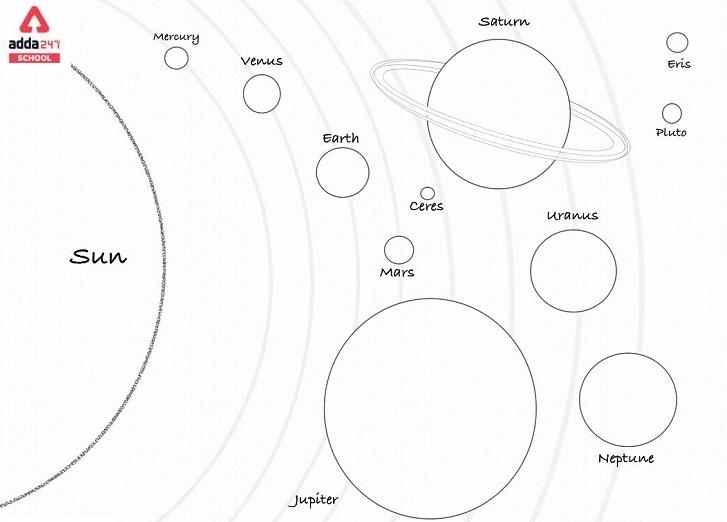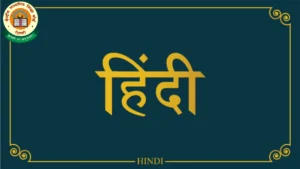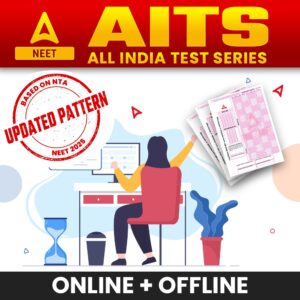Table of Contents
Solar System
Solar System: The Solar System, in simple words, is the gravitationally bound system of the Sun and the objects that orbit it. To put it another way, a solar system is an assemblage made up of the Sun—a typical star in the Milky Way Galaxy—and the things that orbit it. The eight planets are the largest objects that orbit the Sun directly, with the dwarf planets and minor Solar System bodies constituting the rest.
Solar System Diagram
The Solar System was formed by the gravitational collapse of a large interstellar molecular cloud 4.6 billion years ago, and the Sun contains the vast majority of the system’s mass. Mercury, Venus, Earth, and Mars, the four smaller inner system planets. Mercury, Venus, Earth, and Mars are also called terrestrial planets. Mercury, Venus, Earth, and Mars are made mostly of rock and metal. The four planets in the outer system are also called gigantic planets. These gigantic planets are Jupiter and Saturn, the two largest planets, are gas giants made mostly of hydrogen and helium. Uranus and Neptune, the two outermost planets, are ice giants, made up largely of materials with high melting points. solar system diagram shows the orbits of all eight planets are roughly round and lie inside a nearly flat disc known as the ecliptic.

Solar System Drawing for School Project
In the solar system, there are eight planets. Mercury, Venus, Earth, and Mars are the four inner terrestrial planets, all of which are mostly made of rock. Jupiter, Saturn, Neptune, and Uranus are the four outer planets, which are gigantic planets made mostly of gases or ice. Pluto was thought to be the ninth planet until 2006 when the International Astronomical Union decided to categorise it as a dwarf planet.
The Sun, which holds more than 99 per cent of the mass of the solar system and influences the motion of all other bodies by its gravitational attraction, is at the centre of the solar system.
Apart from the planets and the sun, Smaller objects can also be found in the Solar System. The asteroid belt, which sits between Mars and Jupiter’s orbits, is primarily made up of rock and metal objects, similar to the terrestrial planets. The Kuiper belt and dispersed disc are populations of trans-Neptunian objects largely made of ices. The Kuiper belt and dispersed disc sit beyond Neptune’s orbit, as does a newly discovered population of sednoids. Some objects among these populations are massive enough to have rounded under their own gravity, however, how many there will be is a matter of discussion. Other small-body populations, like comets, centaurs, and interplanetary dust clouds, are also free to move across areas.

Solar System Drawing for Kids in Details
The planets and dwarf planets in the Kuiper belt, as well as rocky asteroids and icy things, orbit the Sun in elliptical orbits in the same direction as the Sun revolves, a motion known as prograde. An observer looking down on the system from a vantage point above Earth’s North Pole would see that all of the orbital motions are counterclockwise. The comet nuclei in the Oort cloud, on the other hand, are on orbits with unpredictable directions.
Venus and Neptune have the most circular orbits around the Sun of the eight main planets. The inclination and eccentricity of an object’s orbit around the Sun are defining characteristics.
Read: 7 Continents
Solar System Planets in Order Easy to learn
- Mercury – 0.39 AU from the sun
- Venus – 0.72 AU
- Earth – 1.00 AU
- Mars – 1.52 AU
- Jupiter – 5.20 AU
- Saturn – 9.54 AU
- Uranus – 19.20 AU
- Neptune – 30.06 AU
Solar System Planets and their density
On the basis of their densities, the eight planets can be split into two groups. The four inner planets, also known as the Jovian or giant planets, have rocky compositions and densities larger than 3 grammes per cubic cm, whereas the four outer planets, also known as the Jovian or giant planets, are huge objects with densities less than 2 grammes per cubic cm. Pluto is a one-of-a-kind dwarf planet, consisting of ice, low-density material. The inner planets are generally tiny and have solid surfaces, no ring systems, and few or no moons.
Solar System Planets and moons
Only Earth has a strong magnetic field that protects it from the interplanetary medium among the inner planets. The magnetosphere is an area surrounding Earth where the magnetic field captures some of the interplanetary medium’s electrically charged particles. The Van Allen belts in the inner magnetosphere have substantial concentrations of these high-energy particles. The four large outer planets are far more massive than the terrestrial planets, with massive atmospheres dominated by hydrogen and helium. They don’t have solid surfaces, and their densities are so low that one of them, Saturn, could float on water. Each of the outer planets has its own magnetic field, ring system, and numerous known moons, with more on the way. Pluto has only five known moons and no known rings. The majority of known moons orbit their planets in the same direction as the planets orbit the Sun. They represent a wide range of settings and are incredibly diverse. Io, Jupiter’s largest moon, is orbited by Saturn’s largest moon, Titan, which is wracked by tremendous volcanism. Triton orbits Neptune in a backward motion.
सोलर सिस्टम in Hindi
सोलर सिस्टम ड्रॉइंग: सोलर सिस्टम, सरल शब्दों में, सूर्य की गुरुत्वाकर्षण से बंधी हुई प्रणाली और उसकी परिक्रमा करने वाले पिंड हैं। इसे दूसरे तरीके से रखने के लिए, एक सौर मंडल सूर्य से बना एक संयोजन है – मिल्की वे गैलेक्सी में एक विशिष्ट तारा – और जो चीजें इसकी परिक्रमा करती हैं। आठ ग्रह सबसे बड़े पिंड हैं जो सीधे सूर्य की परिक्रमा करते हैं, बौने ग्रह और छोटे सौर मंडल के पिंड बाकी का गठन करते हैं।
सौर मंडल का निर्माण 4.6 अरब साल पहले एक बड़े अंतरतारकीय आणविक बादल के गुरुत्वाकर्षण के पतन से हुआ था, और सूर्य में प्रणाली के द्रव्यमान का विशाल बहुमत शामिल है। बुध, शुक्र, पृथ्वी और मंगल, चार छोटे आंतरिक प्रणाली ग्रह। बुध, शुक्र, पृथ्वी और मंगल को पार्थिव ग्रह भी कहा जाता है। बुध, शुक्र, पृथ्वी और मंगल ज्यादातर चट्टान और धातु से बने हैं। बाह्य मण्डल के चारों ग्रहों को विशाल ग्रह भी कहा जाता है। ये विशाल ग्रह हैं बृहस्पति और शनि, दो सबसे बड़े ग्रह, गैस के दैत्य हैं जो ज्यादातर हाइड्रोजन और हीलियम से बने हैं। यूरेनस और नेपच्यून, दो सबसे बाहरी ग्रह, बर्फ के दिग्गज हैं, जो बड़े पैमाने पर उच्च गलनांक वाली सामग्री से बने हैं। सभी आठ ग्रहों की कक्षाएँ मोटे तौर पर गोल हैं और लगभग एक सपाट डिस्क के अंदर स्थित हैं जिसे एक्लिप्टिक कहा जाता है।
सौरमंडल में आठ ग्रह हैं। बुध, शुक्र, पृथ्वी और मंगल चार आंतरिक स्थलीय ग्रह हैं, जिनमें से सभी ज्यादातर चट्टान से बने हैं। बृहस्पति, शनि, नेपच्यून और यूरेनस चार बाहरी ग्रह हैं, जो विशाल ग्रह हैं जो ज्यादातर गैसों या बर्फ से बने हैं। 2006 तक प्लूटो को नौवां ग्रह माना जाता था जब अंतर्राष्ट्रीय खगोलीय संघ ने इसे बौने ग्रह के रूप में वर्गीकृत करने का निर्णय लिया।
सूर्य, जो सौर मंडल के 99 प्रतिशत से अधिक द्रव्यमान रखता है और अपने गुरुत्वाकर्षण आकर्षण से अन्य सभी निकायों की गति को प्रभावित करता है, सौर मंडल के केंद्र में है।
सौर मंडल में ग्रहों और सूर्य के अलावा छोटी-छोटी वस्तुएं भी पाई जा सकती हैं। क्षुद्रग्रह बेल्ट, जो मंगल और बृहस्पति की कक्षाओं के बीच बैठता है, मुख्य रूप से स्थलीय ग्रहों के समान चट्टान और धातु की वस्तुओं से बना है। कुइपर बेल्ट और छितरी हुई डिस्क बड़े पैमाने पर बर्फ से बनी ट्रांस-नेप्च्यूनियन वस्तुओं की आबादी है। कुइपर बेल्ट और छितरी हुई डिस्क नेप्च्यून की कक्षा से परे बैठती है, जैसा कि सेडनोइड्स की एक नई खोजी गई आबादी है। इन आबादी के बीच कुछ वस्तुएं अपने गुरुत्वाकर्षण के तहत गोल करने के लिए काफी बड़ी हैं, हालांकि, कितने होंगे यह चर्चा का विषय है। अन्य छोटे शरीर की आबादी, जैसे धूमकेतु, सेंटोरस, और ग्रहों के बीच धूल के बादल, भी क्षेत्रों में जाने के लिए स्वतंत्र हैं।
कुइपर बेल्ट में ग्रह और बौने ग्रह, साथ ही चट्टानी क्षुद्रग्रह और बर्फीली चीजें, सूर्य की परिक्रमा उसी दिशा में अण्डाकार कक्षाओं में करते हैं, जिस दिशा में सूर्य घूमता है, एक गति जिसे प्रोग्रेड के रूप में जाना जाता है। पृथ्वी के उत्तरी ध्रुव के ऊपर एक सुविधाजनक बिंदु से सिस्टम को नीचे देखने वाला एक पर्यवेक्षक यह देखेगा कि सभी कक्षीय गति वामावर्त हैं। दूसरी ओर, ऊर्ट बादल में धूमकेतु के नाभिक अप्रत्याशित दिशाओं के साथ कक्षाओं में हैं।
शुक्र और नेपच्यून की आठ मुख्य ग्रहों में से सूर्य के चारों ओर सबसे अधिक गोलाकार कक्षाएँ हैं। सूर्य के चारों ओर किसी वस्तु की कक्षा का झुकाव और विलक्षणता विशेषताओं को परिभाषित कर रही है।
How do Kids draw a solar system drawing for a school projects?
Solar System Project
Creating a solar system project is a fantastic way to learn about the planets, their characteristics, and the overall structure of our solar system. Whether you’re working on this project for school or just for fun, here’s a step-by-step guide to help you get started:
Materials You’ll Need:
- Styrofoam balls or foam spheres (different sizes to represent planets)
- Acrylic paints or markers
- Paintbrushes
- Wooden dowels or sticks
- String or fishing line
- Glue
- Cardboard or a shoebox for the base
- A small LED or flashlight (optional for a sun model)
- Space-themed stickers or images (optional)
- Reference materials or books about the solar system
Steps to Create Your Solar System Project:
- Research: Begin by gathering information about the solar system. Understand the order of the planets from the Sun, their sizes, distances from the Sun, and any unique features or characteristics.
- Plan: Decide on the scale of your project. Will you create a small-scale model or a larger, more detailed one? Sketch out your ideas.
- Create the Sun: If you’re making a 3D model of the Sun, use a large Styrofoam ball or a circular object like a balloon. Paint it in a bright yellow or orange color. You can also attach an LED or flashlight to represent the Sun’s light.
- Design the Planets: For each planet, take the appropriately sized Styrofoam ball and paint it to resemble the planet’s appearance. Here’s a basic guide:
- Mercury: Gray with craters
- Venus: Yellow with clouds
- Earth: Blue and green with continents
- Mars: Red with surface features
- Jupiter: Orange with bands and a “Great Red Spot”
- Saturn: Light yellow with rings
- Uranus: Light blue-green
- Neptune: Dark blue with storms
- Assemble the Planets: Attach wooden dowels or sticks to each painted planet. These will serve as the planet’s orbits. You may need to cut the sticks to different lengths based on the planet’s distance from the Sun.
- Create the Base: Cut a piece of cardboard or use a shoebox lid as the base for your solar system. Paint it black to represent outer space or add space-themed stickers/images for decoration.
- Arrange the Planets: Attach the planets to their respective orbits on the base using glue. Make sure to position them in the correct order from the Sun.
- Add Labels: Label each planet with its name using a fine-tip marker. You can also include information like the planet’s diameter and distance from the Sun.
- Hang It Up: If you want to create a hanging display, attach strings or fishing line to the top of each planet’s orbit stick and secure the other end to the base. Make sure the planets are evenly spaced.
- Present Your Project: When presenting your solar system project, explain the key details about each planet, including its unique characteristics and its place in the solar system.
Remember to be creative and have fun with your project. You can add additional elements like asteroid belts or moons to make it more interesting and educational. Good luck with your solar system project!


 CBSE Class 12 Hindi Expected Question Pa...
CBSE Class 12 Hindi Expected Question Pa...
 The Scientific Daily Routine for Student...
The Scientific Daily Routine for Student...
 CUET Maths Syllabus 2025 PDF, Pattern, B...
CUET Maths Syllabus 2025 PDF, Pattern, B...







